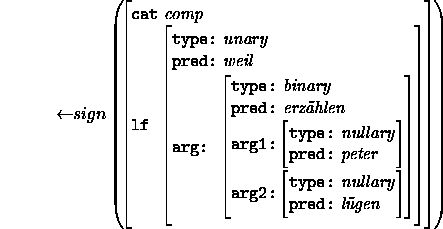As already noted in chapter 3 a query p as input for parsing or generation is a possibly empty conjunction of an -atom and a -constraint, written as:
![]()
Usually, the query corresponds to the root node of the grammar, where the constraints include at least the string to parse or the semantics to generate. For example, using the lexical grammar of appendix A for parsing the sentence ``weil peter lügen erzählt'' the goal statement would be
![]()
while the goal statement for generating this string would be

However, in order to bind the resulting constraint so that we can
easily return it as a value from the underlying proof procedure, we specify
the goal statement as the negative literal of an -atom
that does not belong to the grammar or lexicon. The constraints of the
new atom will be the same as the goal statement. Thus for the example
above the goal statement will be specified as![]()

If this clause can be reduced, the constraints on the head will
also express the resulting feature structure which then can easily be
returned as output from the proof procedure.![]()
The general structure of such item is:
![]()
where p is a predicate of the grammar, ans a predicate not in the
grammar, ![]() the index
of the selected element. We will denote such item as the start item.
the index
of the selected element. We will denote such item as the start item.